Kumar Ashutosh
IIT Bombay
Stitch-a-Recipe: Video Demonstration from Multistep Descriptions
Mar 18, 2025



Abstract:When obtaining visual illustrations from text descriptions, today's methods take a description with-a single text context caption, or an action description-and retrieve or generate the matching visual context. However, prior work does not permit visual illustration of multistep descriptions, e.g. a cooking recipe composed of multiple steps. Furthermore, simply handling each step description in isolation would result in an incoherent demonstration. We propose Stitch-a-Recipe, a novel retrieval-based method to assemble a video demonstration from a multistep description. The resulting video contains clips, possibly from different sources, that accurately reflect all the step descriptions, while being visually coherent. We formulate a training pipeline that creates large-scale weakly supervised data containing diverse and novel recipes and injects hard negatives that promote both correctness and coherence. Validated on in-the-wild instructional videos, Stitch-a-Recipe achieves state-of-the-art performance, with quantitative gains up to 24% as well as dramatic wins in a human preference study.
LLMs can see and hear without any training
Jan 30, 2025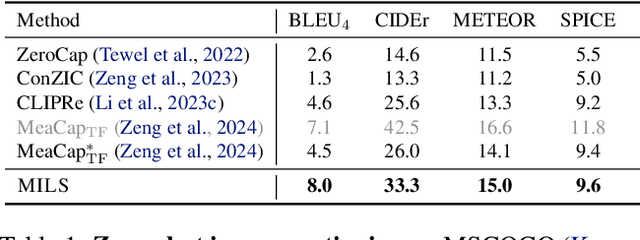
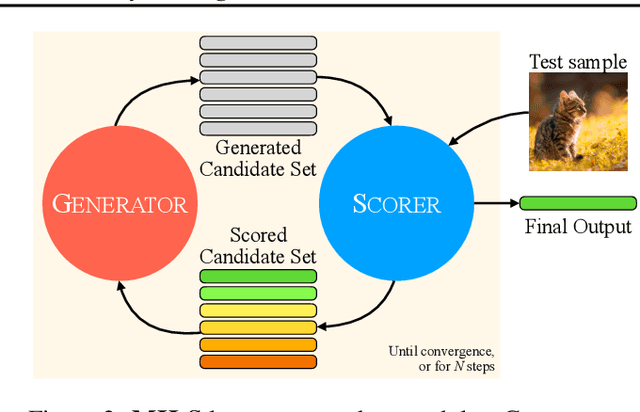

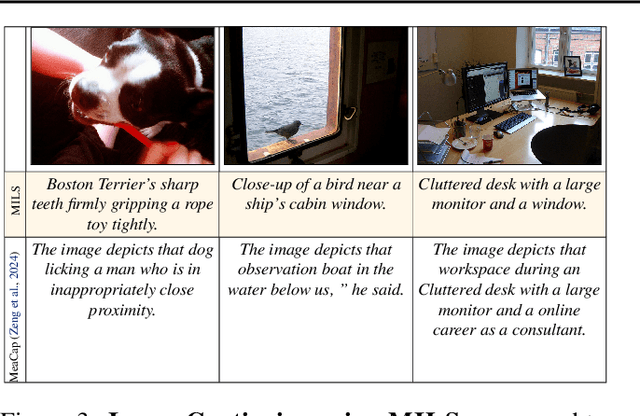
Abstract:We present MILS: Multimodal Iterative LLM Solver, a surprisingly simple, training-free approach, to imbue multimodal capabilities into your favorite LLM. Leveraging their innate ability to perform multi-step reasoning, MILS prompts the LLM to generate candidate outputs, each of which are scored and fed back iteratively, eventually generating a solution to the task. This enables various applications that typically require training specialized models on task-specific data. In particular, we establish a new state-of-the-art on emergent zero-shot image, video and audio captioning. MILS seamlessly applies to media generation as well, discovering prompt rewrites to improve text-to-image generation, and even edit prompts for style transfer! Finally, being a gradient-free optimization approach, MILS can invert multimodal embeddings into text, enabling applications like cross-modal arithmetic.
FIction: 4D Future Interaction Prediction from Video
Dec 01, 2024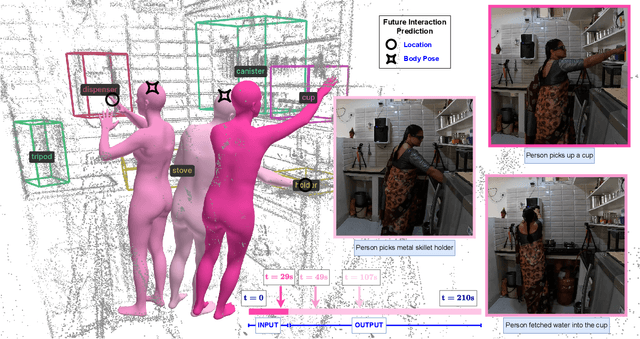

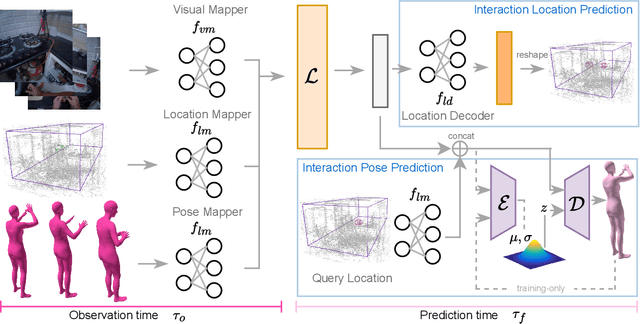
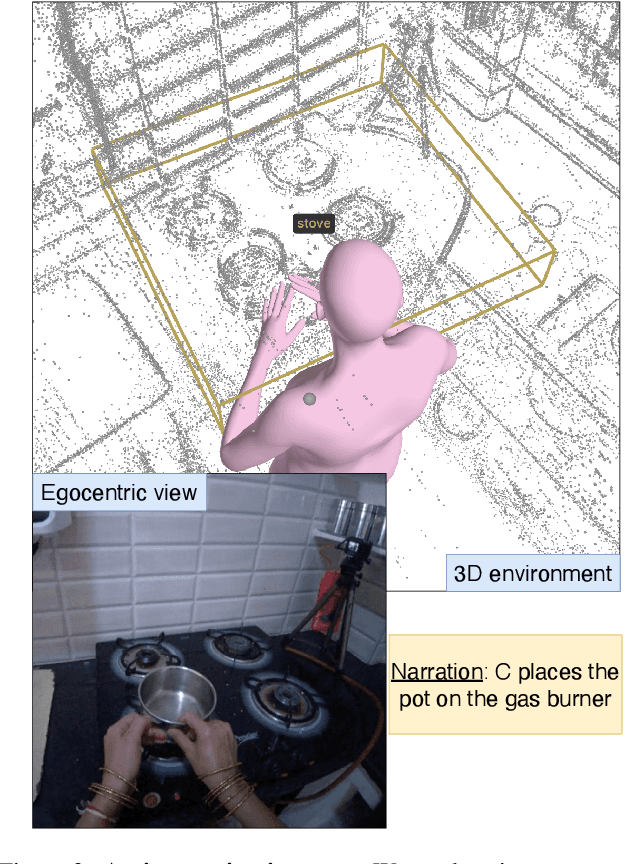
Abstract:Anticipating how a person will interact with objects in an environment is essential for activity understanding, but existing methods are limited to the 2D space of video frames-capturing physically ungrounded predictions of 'what' and ignoring the 'where' and 'how'. We introduce 4D future interaction prediction from videos. Given an input video of a human activity, the goal is to predict what objects at what 3D locations the person will interact with in the next time period (e.g., cabinet, fridge), and how they will execute that interaction (e.g., poses for bending, reaching, pulling). We propose a novel model FIction that fuses the past video observation of the person's actions and their environment to predict both the 'where' and 'how' of future interactions. Through comprehensive experiments on a variety of activities and real-world environments in Ego-Exo4D, we show that our proposed approach outperforms prior autoregressive and (lifted) 2D video models substantially, with more than 30% relative gains.
ExpertAF: Expert Actionable Feedback from Video
Aug 01, 2024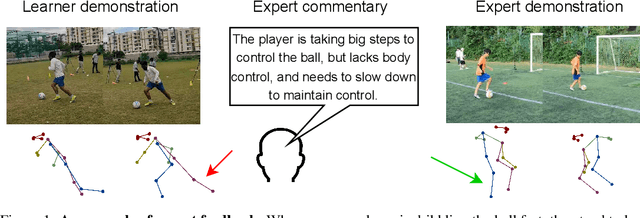
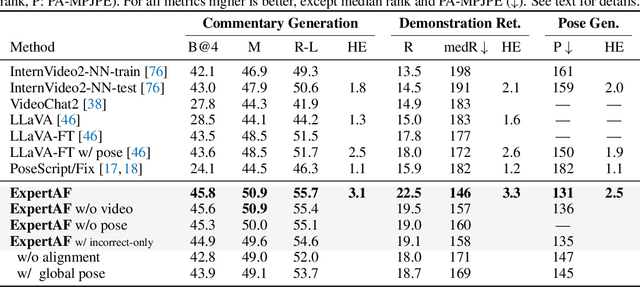
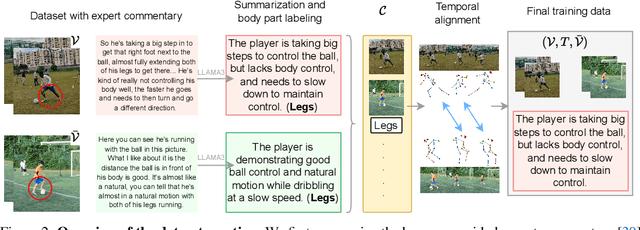
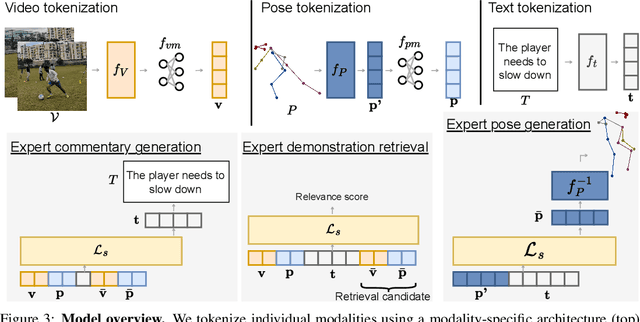
Abstract:Feedback is essential for learning a new skill or improving one's current skill-level. However, current methods for skill-assessment from video only provide scores or compare demonstrations, leaving the burden of knowing what to do differently on the user. We introduce a novel method to generate actionable feedback from video of a person doing a physical activity, such as basketball or soccer. Our method takes a video demonstration and its accompanying 3D body pose and generates (1) free-form expert commentary describing what the person is doing well and what they could improve, and (2) a visual expert demonstration that incorporates the required corrections. We show how to leverage Ego-Exo4D's videos of skilled activity and expert commentary together with a strong language model to create a weakly-supervised training dataset for this task, and we devise a multimodal video-language model to infer coaching feedback. Our method is able to reason across multi-modal input combinations to output full-spectrum, actionable coaching -- expert commentary, expert video retrieval, and the first-of-its-kind expert pose generation -- outperforming strong vision-language models on both established metrics and human preference studies.
SoundingActions: Learning How Actions Sound from Narrated Egocentric Videos
Apr 08, 2024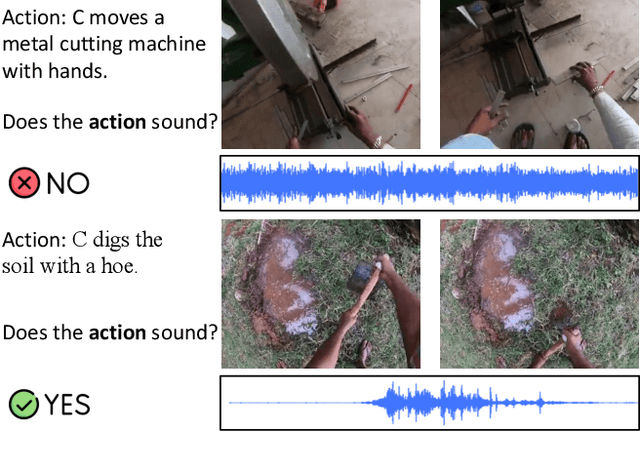

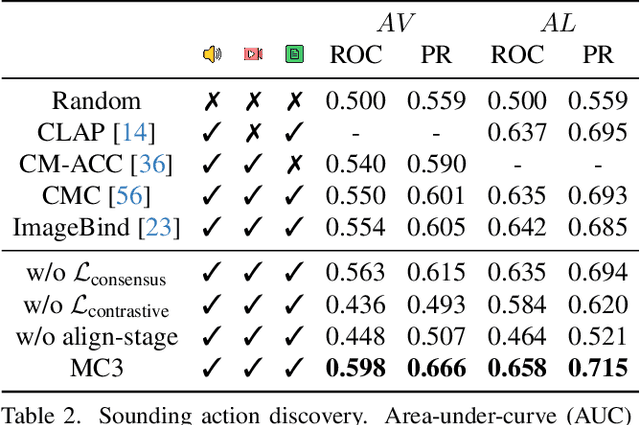

Abstract:We propose a novel self-supervised embedding to learn how actions sound from narrated in-the-wild egocentric videos. Whereas existing methods rely on curated data with known audio-visual correspondence, our multimodal contrastive-consensus coding (MC3) embedding reinforces the associations between audio, language, and vision when all modality pairs agree, while diminishing those associations when any one pair does not. We show our approach can successfully discover how the long tail of human actions sound from egocentric video, outperforming an array of recent multimodal embedding techniques on two datasets (Ego4D and EPIC-Sounds) and multiple cross-modal tasks.
Detours for Navigating Instructional Videos
Jan 03, 2024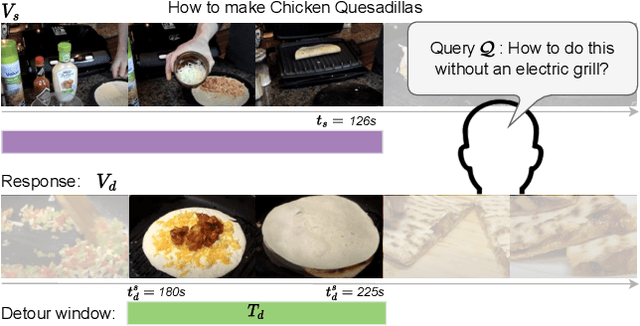

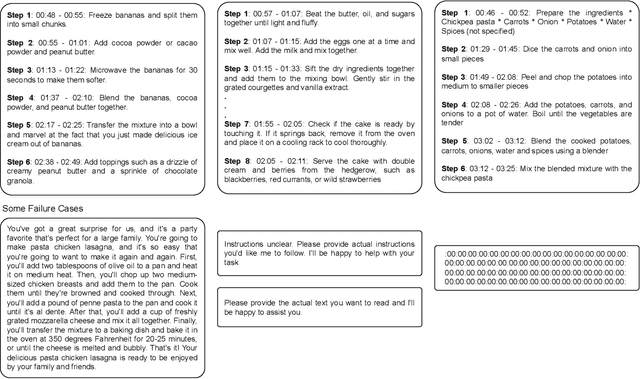

Abstract:We introduce the video detours problem for navigating instructional videos. Given a source video and a natural language query asking to alter the how-to video's current path of execution in a certain way, the goal is to find a related ''detour video'' that satisfies the requested alteration. To address this challenge, we propose VidDetours, a novel video-language approach that learns to retrieve the targeted temporal segments from a large repository of how-to's using video-and-text conditioned queries. Furthermore, we devise a language-based pipeline that exploits how-to video narration text to create weakly supervised training data. We demonstrate our idea applied to the domain of how-to cooking videos, where a user can detour from their current recipe to find steps with alternate ingredients, tools, and techniques. Validating on a ground truth annotated dataset of 16K samples, we show our model's significant improvements over best available methods for video retrieval and question answering, with recall rates exceeding the state of the art by 35%.
Learning Object State Changes in Videos: An Open-World Perspective
Dec 19, 2023
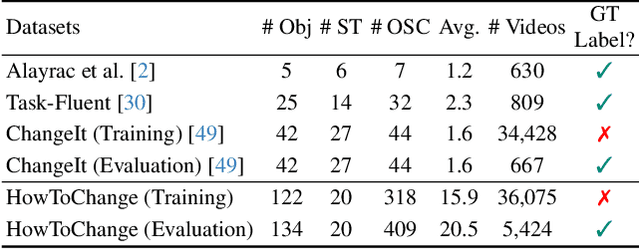
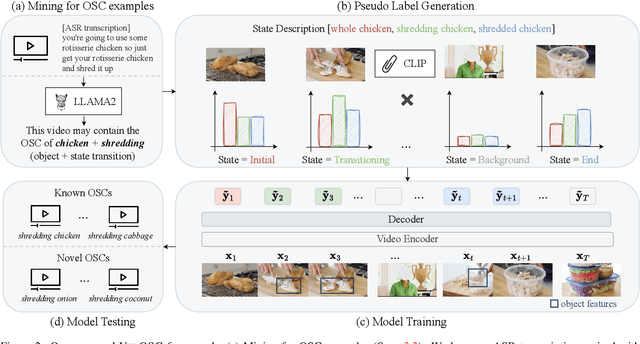

Abstract:Object State Changes (OSCs) are pivotal for video understanding. While humans can effortlessly generalize OSC understanding from familiar to unknown objects, current approaches are confined to a closed vocabulary. Addressing this gap, we introduce a novel open-world formulation for the video OSC problem. The goal is to temporally localize the three stages of an OSC -- the object's initial state, its transitioning state, and its end state -- whether or not the object has been observed during training. Towards this end, we develop VidOSC, a holistic learning approach that: (1) leverages text and vision-language models for supervisory signals to obviate manually labeling OSC training data, and (2) abstracts fine-grained shared state representations from objects to enhance generalization. Furthermore, we present HowToChange, the first open-world benchmark for video OSC localization, which offers an order of magnitude increase in the label space and annotation volume compared to the best existing benchmark. Experimental results demonstrate the efficacy of our approach, in both traditional closed-world and open-world scenarios.
Ego-Exo4D: Understanding Skilled Human Activity from First- and Third-Person Perspectives
Nov 30, 2023



Abstract:We present Ego-Exo4D, a diverse, large-scale multimodal multiview video dataset and benchmark challenge. Ego-Exo4D centers around simultaneously-captured egocentric and exocentric video of skilled human activities (e.g., sports, music, dance, bike repair). More than 800 participants from 13 cities worldwide performed these activities in 131 different natural scene contexts, yielding long-form captures from 1 to 42 minutes each and 1,422 hours of video combined. The multimodal nature of the dataset is unprecedented: the video is accompanied by multichannel audio, eye gaze, 3D point clouds, camera poses, IMU, and multiple paired language descriptions -- including a novel "expert commentary" done by coaches and teachers and tailored to the skilled-activity domain. To push the frontier of first-person video understanding of skilled human activity, we also present a suite of benchmark tasks and their annotations, including fine-grained activity understanding, proficiency estimation, cross-view translation, and 3D hand/body pose. All resources will be open sourced to fuel new research in the community.
Video-Mined Task Graphs for Keystep Recognition in Instructional Videos
Jul 17, 2023



Abstract:Procedural activity understanding requires perceiving human actions in terms of a broader task, where multiple keysteps are performed in sequence across a long video to reach a final goal state -- such as the steps of a recipe or a DIY fix-it task. Prior work largely treats keystep recognition in isolation of this broader structure, or else rigidly confines keysteps to align with a predefined sequential script. We propose discovering a task graph automatically from how-to videos to represent probabilistically how people tend to execute keysteps, and then leverage this graph to regularize keystep recognition in novel videos. On multiple datasets of real-world instructional videos, we show the impact: more reliable zero-shot keystep localization and improved video representation learning, exceeding the state of the art.
What You Say Is What You Show: Visual Narration Detection in Instructional Videos
Jan 05, 2023Abstract:Narrated "how-to" videos have emerged as a promising data source for a wide range of learning problems, from learning visual representations to training robot policies. However, this data is extremely noisy, as the narrations do not always describe the actions demonstrated in the video. To address this problem we introduce the novel task of visual narration detection, which entails determining whether a narration is visually depicted by the actions in the video. We propose "What You Say is What You Show" (WYS^2), a method that leverages multi-modal cues and pseudo-labeling to learn to detect visual narrations with only weakly labeled data. We further generalize our approach to operate on only audio input, learning properties of the narrator's voice that hint if they are currently doing what they describe. Our model successfully detects visual narrations in in-the-wild videos, outperforming strong baselines, and we demonstrate its impact for state-of-the-art summarization and alignment of instructional video.
 Add to Chrome
Add to Chrome Add to Firefox
Add to Firefox Add to Edge
Add to Edge